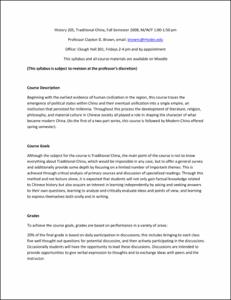Please use this identifier to cite or link to this item:
http://hdl.handle.net/10267/3354| Title: | HIST 205-05, Traditional China, Fall 2008 |
| Authors: | Brown, Clayton D. |
| Keywords: | History, Department of;Syllabus;Curriculum;Academic departments;Text;2008 Fall |
| Issue Date: | 25-Aug-2008 |
| Publisher: | Memphis, Tenn. : Rhodes College |
| Series/Report no.: | Syllabi CRN 19253 |
| Abstract: | Beginning with the earliest evidence of human civilization in the region, this course traces the emergence of political states within China and their eventual unification into a single empire, an institution that persisted for millennia. Throughout this process the development of literature, religion, philosophy, and material culture in Chinese society all played a role in shaping the character of what became modern China. (As the first of a two part series, this course is followed by Modern China offered spring semester).Although the subject for the course is Traditional China, the main point of the course is not to know everything about Traditional China, which would be impossible in any case, but to offer a general survey and additionally provide some depth by focusing on a limited number of important themes. This is achieved through critical analysis of primary sources and discussion of specialized readings. Through this method and not lecture alone, it is expected that students will not only gain factual knowledge related to Chinese history but also acquire an interest in learning independently by asking and seeking answers to their own questions, learning to analyze and critically evaluate ideas and points of view, and learning to express themselves both orally and in writing. |
| Description: | This syllabus was submitted to the Office of Academic Affairs by the course instructor |
| URI: | http://hdl.handle.net/10267/3354 |
| Appears in Collections: | Course Syllabi |
Files in This Item:
| File | Description | Size | Format | |
|---|---|---|---|---|
| 2008_fall_HIST_205-05_19253.pdf | 386.28 kB | Adobe PDF |  View/Open |
Items in DSpace are protected by copyright, with all rights reserved, unless otherwise indicated.